Designed for Hardkernel’s 15th anniversary, the ODROID-M1S is a smaller, cheaper ($49 and up), and more efficient single computer board compared to the ODROID-M1 single board computer introduced last year with a Rockchip RK3568 SoC.
The new ODROID-M1S SBC features a Rockchip RK3566 SoC which is similar to the RK3568, but with fewer peripheral interfaces, 4GB or 8GB LPDDR4 memory, a 64GB eMMC flash solder on the board (instead of an eMMC flash connector), HDMI 2.0 and MIPI DSI video interfaces, gigabit Ethernet, a few USB ports, and two GPIO headers. It does lose a few features compared to the ODROID-M1, as its memory is clocked at a lower speed, the M.2 socket only supports PCIe 2.1, the SPI flash and SATA port are gone, and so is the MIPI CSI camera connector. The power supply has also changed from a 12V DC jack to a 5V USB-C port.
ODROID-M1S specifications with highlights in bold or strikethrough showing the difference against ODROID-M1:
- SoC – Rockchip RK3566 quad-core Cortex-A55 processor @ up to 1.8 GHz with Arm Mali-G52 MP2 GPU @ 800 MHz, 0.8 TOPS AI accelerator
- System Memory – 4GB or 8GB LPDDR4 RAM at 2112 MT/s or up to 1,055 MHz
- Storage
16MB SPI flash- 64GB eMMC flash (soldered on PCB) benchmarked at up to 180MB/s with fio
- MicroSD card slot (UHS-I SDR104, boot priority higher than eMMC flash)
- M.2 NVMe M-Key 2280 socket (1-lane PCIe 2.1) benchmarked at up to 400MB/s with fio (Note: ODROID-M1 could support 1,600MB/s thanks to PCIe 3.0)
Native SATA 3.0 port + SATA power (5V only) tested up to around 500 MB/s
- Video Output
- 1x HDMI 2.0 port up to 4Kp60 with HDR, EDID
- 4-lane MIPI DSI connector (30-pin, while ODROID M1 has a 31-pin connector)
Camera I/F – 1x 2-lame MIPI CSI connector- Audio – 3.5mm headphone jack, mono speaker output (1.3W at 8Ω load)
- Networking – Gigabit Ethernet RJ45 port via Realtek RTL8211F Ethernet transceiver
- USB
- 1x USB 3.0 port
- 1x USB 2.0 port
- 1x Micro USB 2.0 OTG port
- Expansion – 40-pin GPIO header + 14-pin GPIO header (both headers optional)
- Debugging – UART header for serial console
- Misc –
Power button,SPI Boot Select switch, IR receiver, RTC batteryholderconnector,jumper, 2x system LEDs, M.2 LED - Power Supply – 5V/3A via USB Type-C port
- Power consumption
- Power off – 0 Watt
- Idle – 1.1 Watt (vs 1.3 Watt)
- CPU stress – 3.52 Watts with performance governor (vs 4.5 Watts)
- Dimensions – 90 x 65 x 16mm (ODROID-M1: 123 x 100 x 19mm with heatsink)
- Weight – 52 grams with heatsink
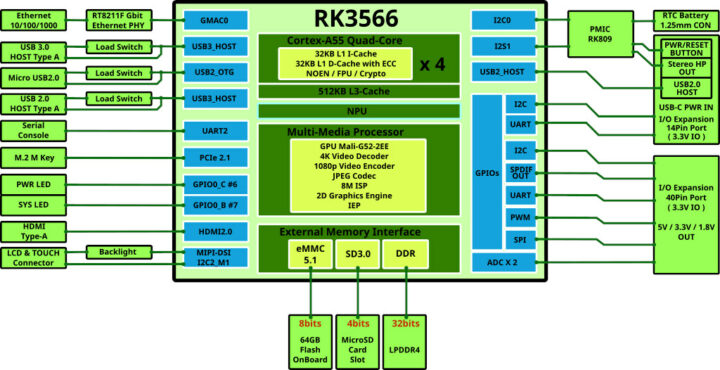
Since Rockchip RK3566 and RK3568 are mostly software compatible, the new ODROID-M1S SBC can leverage existing support for the ODROID-M1, and Hardkernel provides Ubuntu 20.04 LTS with Linux 5.10.160, Ubuntu 22.04 LTS with Linux 6.1.60 (and open-source Panfrost driver for the Mali GPU), Android 11 (AOSP) images for the board. People who are used to controlling GPIOs on a Raspberry Pi using the WiringPi library may be interested to know the library is also present in the Ubuntu images for the ODROID-M1S. There’s also a detailed wiki explaining how to get started, use the board with Ubuntu or Ubuntu, and build the images from scratch.
Performance is close to the one of the ODROID-M1, but in some cases, the ODROID-M1S is a bit slower (e.g. AI benchmark running on the NPU) due to the lower memory bandwidth. The company also measured the CPU temperature underload with RK3566 SBC fitted with its heatsink and housed in the plastic case, and the temperature never exceeded 75°C under load in a room at 25°C, so no fan is needed to operate the board at its maximum performance.
Hardkernel made the changes based on customers’ feedback since they requested a lower price, more GPIO ports, lower power consumption, a slimmer form factor, and a variety of practical peripherals. We’ve already (mostly) addressed the first three in this post, so here’s a list of the peripherals available for the ODROID-M1S:
- ODROID-M1S plastic enclosure
- ODROID-Vu8S (8-inch) and upcoming ODROID-Vu5S (5-inch) capacitive touchscreen displays
- UPS kit for ODROID-M1S taking on 18650 battery
- Mini IO board using the new 14-pin GPIO header to expose USB 2.0 host, Power button, Reset button, Audio line-out 3.5mm phone jack and I2C & UART buses.
- 4-Channel Relay Board
- 6-Channel Stepper Motor Controller Board
- Multi I/O Training Board using both 40-pin and 14-pin GPIO headers with an OLED display, a 5-key keypad, a CAN FD interface, a 3-pin terminal block for power, an RTC battery holder, and extra connectors for ADC, RS232, SPI, and GPIOs.
- Speaker kit with two speakers connected to the 14-pin GPIO header using a small PCB
- CAN FD add-on board with 2-pole terminal block to be used with the Multi IO Training Board or directly on 40-pin GPIO board (TBD)
- Weather Zero board (humidity and temperature sensor)
- Barrel to USB Type-C adapter to connect 8V-17V power supply with a DC jack (5.5/2.1mm)
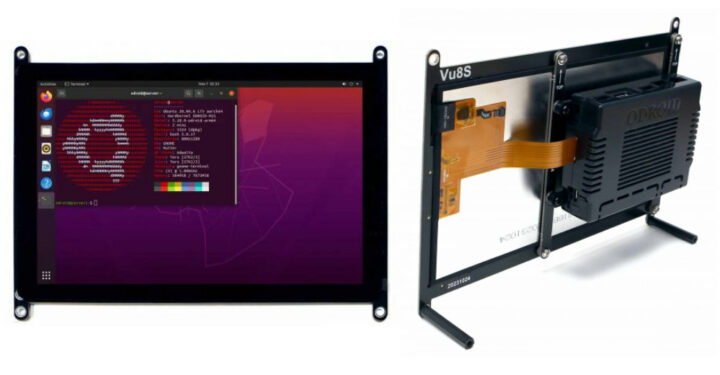
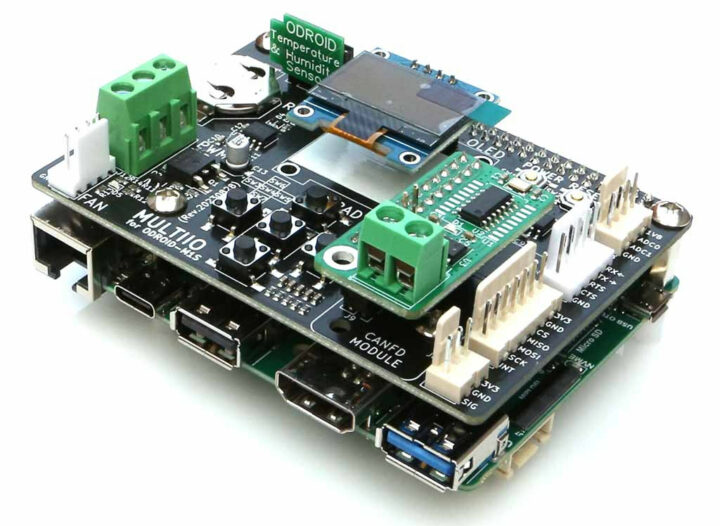
Four variants of the ODROID-M1S are currently available:
- $49 with 4GB RAM, heatsink, case, and power supply
- $52 with 4GB RAM, heatsink, case, power supply, and pre-soldered GPIO headers
- $59 with 8GB RAM, heatsink, case, and power supply
- $62 with 8GB RAM, heatsink, case, power supply, and pre-soldered GPIO headers
You’ll find Hardkernel’s latest Rockchip RK3566 single board computer on the company’s online store. We are told the boards and accessories will be shipped within a few days, but at the same time, the company will be hosting a “Debug Party” by shipping “engineering sample boards and a few selected accessories in a couple of days to our community members”. If you are risk-averse, you may want to wait for a few weeks before going ahead with a purchase. As I wrote this post, Hardkernel contacted us about getting a sample and a few accessories, so there may be a review on CNX Software in a few weeks as well…
Thanks to Tim for the tip.

Jean-Luc started CNX Software in 2010 as a part-time endeavor, before quitting his job as a software engineering manager, and starting to write daily news, and reviews full time later in 2011.
Support CNX Software! Donate via cryptocurrencies, become a Patron on Patreon, or purchase goods on Amazon or Aliexpress. We also use affiliate links in articles to earn commissions if you make a purchase after clicking on those links.


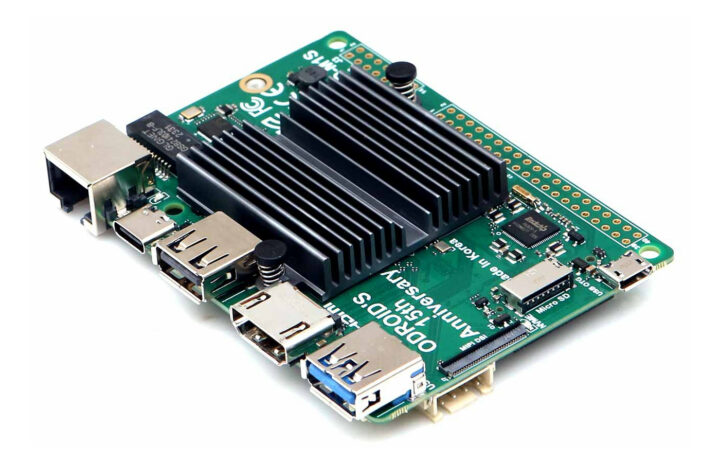
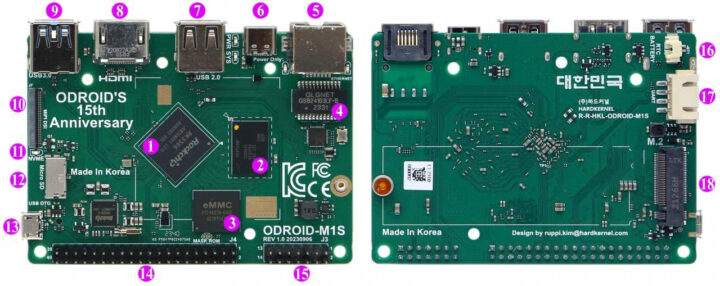
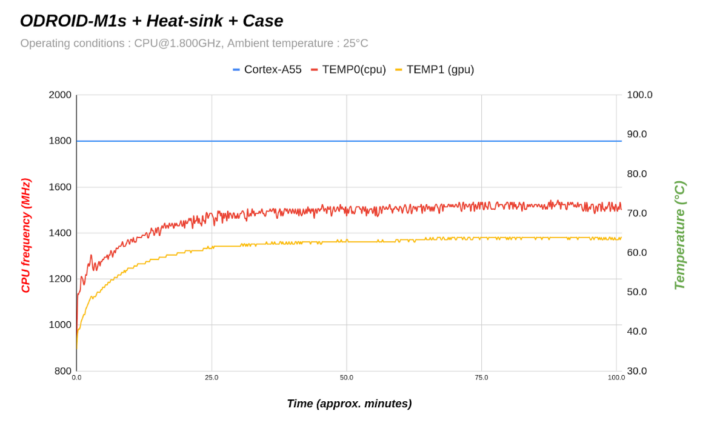


While it doesn’t show anything particularly exciting, it does look quite a versatile and well balanced board that could serve a lot of low-power purposes thanks to its reasonably rich connectivity, onboard storage, and the reduced cooling constraints. And it’s indeed quite cheap. I don’t have any use case right now but I’m realizing that many of my common use cases could fit.
Seems ok, but had quite a few issues with previous odroid boards, cec not working, hdmi dying etc, dunno if there quality has improved since then.
Odd, I’ve got about 15 or so Odroid devices and the only real issue I’ve had was the LAN dying on an XU4 but this was from a nearby lightning strike.
The CEC thing from the C1 was long ago and I’ve not had any such issue with CEC since then.
I second what Tim says, always had great experience with Odroid hardware. I was among those who reported the frequency cheating on Odroid-C2 and it turned out HK wasn’t aware of it and reacted quite well, trying to do their best to address the issue as far as hardware permitted (it was amlogic who cheated on their SoC’s frequency). Recently I bought an Odroid-H3 for my server which I killed by a manipulation mistake (SATA hotplug which apparently brought the 12V into the 5V), they accepted that I attempted to desolder faulty chips to try to fix it myself, I didn’t manage to do so, and they quickly exchanged it regardless of the desoldered chip. Hardware trouble can happen to any vendor, but I would say that HK handles this very seriously, from the schematics to handling issues, passing by the long term support of their boards. And generally speaking their hardware is of particularly good quality, and the only point that sometimes makes me hesitate is only the shipping costs, never the quality!
They have a new shipping method that is supposed to be less expensive.
I think it’s SK Post.
Excellent !
Price is quiet competitive compared to others SBC equiped with RK3566/68.
The 8inch 1280×800 mipi dsi display is at 39$
IMO, this combo could be a really good gift for Christmas 😉
I suppose that with the included heatsink, case, and power supply, this makes it more value.
Having an M.2 slot for mass storage, adds another value driven feature.
Had the RK3566 supported AV1 then this might have been a potentially decent little value media consumption board.
It doesn’t need AV1 considering this codec is not even for small scale adoption much less large scale.
A nicety sure, not necessary but any means for most people.
Sorry for the typos and strange word placement, Gboard seems to be getting worse and worse.
This should have read:
It doesn’t need AV1 considering this codec doesn’t even have small scale adoption much less large scale.
A nicety sure, not necessary by any means for most people.
AV1 is adopted by Facebook/Meta, Netflix, and YouTube for 3 years now. Those platforms and their content are highly adopted by users. Not having hardware decode support impacts the quality of those users’ experience when using those platforms if they instead receive lower quality (8-bit SDR) H.264 streams, and/or higher bandwidth streams for the same quality, and then have network congestion issues leading to stuttering. So it should definitely impact purchasing decisions for hardware, today, for most people who intend to use it for streaming media from the top streaming services / sites.
But if you’re running Debian / Raspberry Pi OS / Yocto, you’re still stuck on an 8-bit desktop regardless. Or if you’re a typical INTJ computer hobbyist with a minimalist mindset using a 10-year-old Toshiba LCD TV as a monitor, then there’s equally no reason to care, lol.
Netflix is not applicable here, I know YouTube has had it for some time.
If these companies are using AV1 they should be using h.265 as well which is supported by nearly all devices released in the past four or so years.
Purchasing from hardkernel is always surprising.
$49.00
Basic Shipping: $17.22
Bank transfer fee: $30.00
Total: $96.22
Don’t forget the 16 weeks warranty you get.
When trying to avoid self-importing new Hardkernel products (waiting a few months until pollin.de has them in stock), then the prices from HK’s online store translate as the following for an individual consumer buy:
yeah that’s usually how it ends up, sadly!
Not really 49 dollars with this stipulation
United Kingdom : We ship over US$190.00 order only.
There’s a new shipping option (at least for me in New Zealand): K-packet, which is much cheaper but with a warning “Very slow option. It may take over a month”. So for me the options are
I never need these things in a hurry so I’m happy to pay a bit less.
Oh.. thank you for letting me know the cheap k-packet option. The shipping cost is only $8.46 to Japan from Korea.
Total Paypal payment is $67.46 for my M1S 8GB order including shipping cost. 🙂
This, I’d say is a perfect alternative to raspberry pi for some really good use cases,
Just considering a full package, an RPi setup would easily cost $100+ with a decent heatsink, case, power, fast storage, and not to mention high priced board only in most cases. I’m ready to replace my old USFF HASS setup with this.
I have ported Home Assistant OS (HAOS) to run on Odroid M1S. Official builds are available now in 12.0rc1!